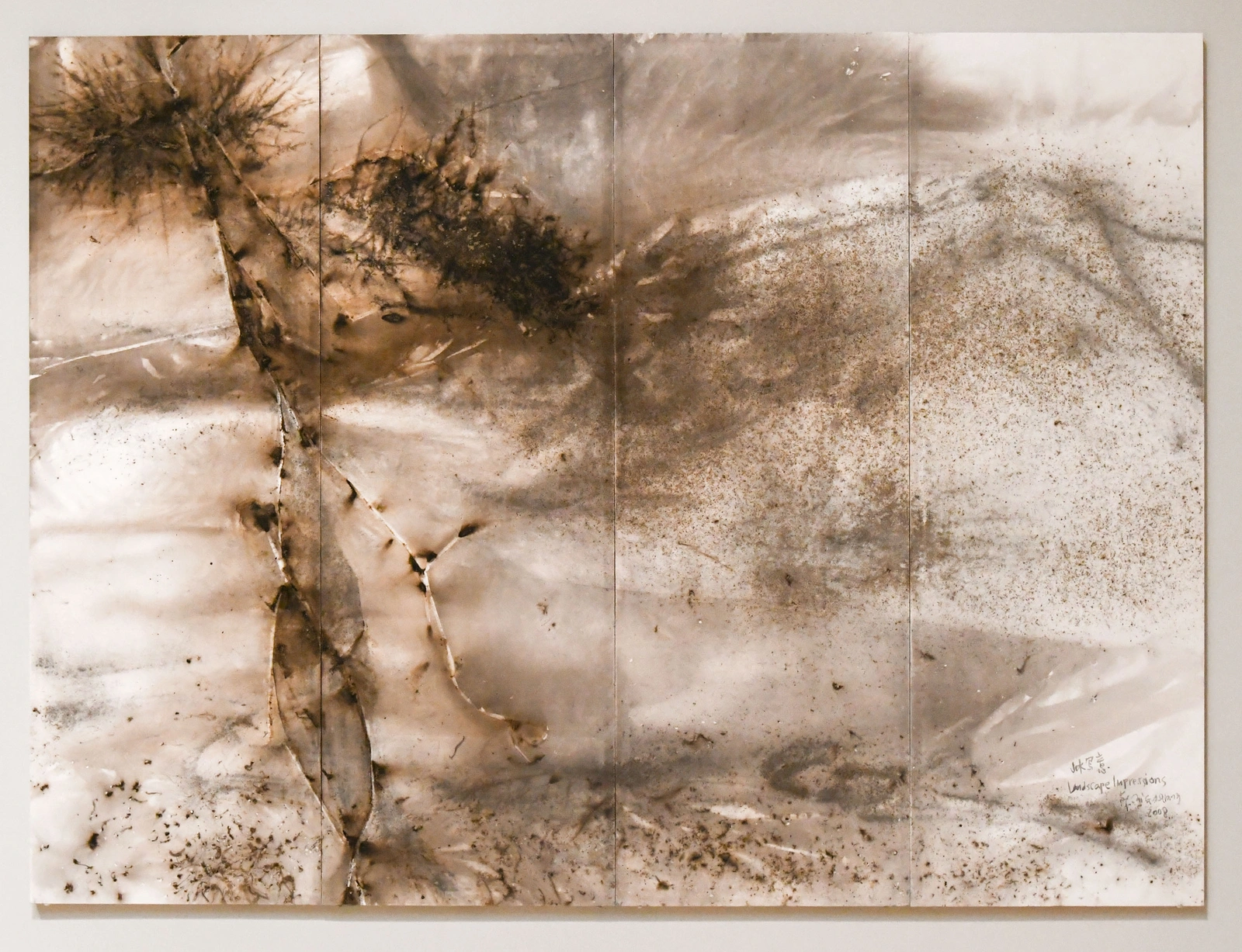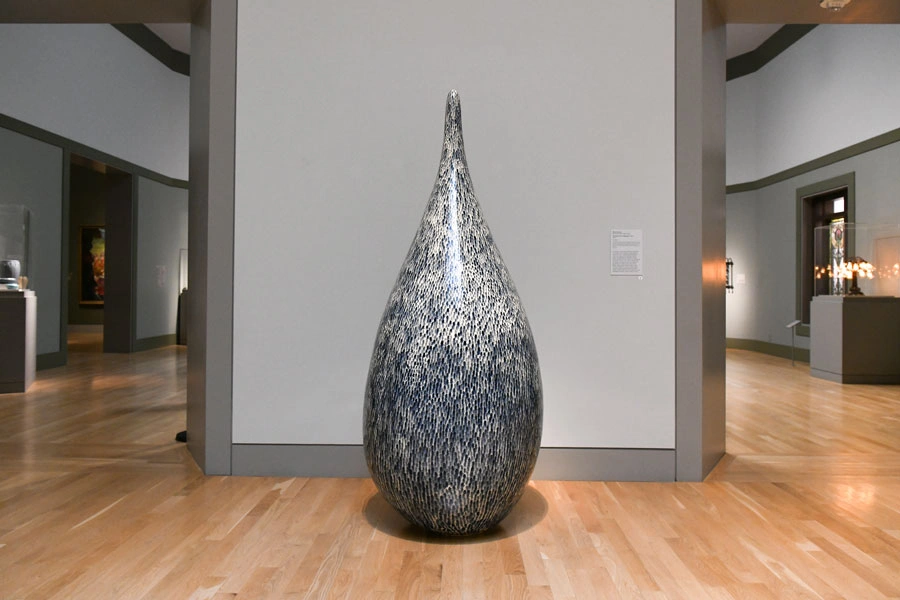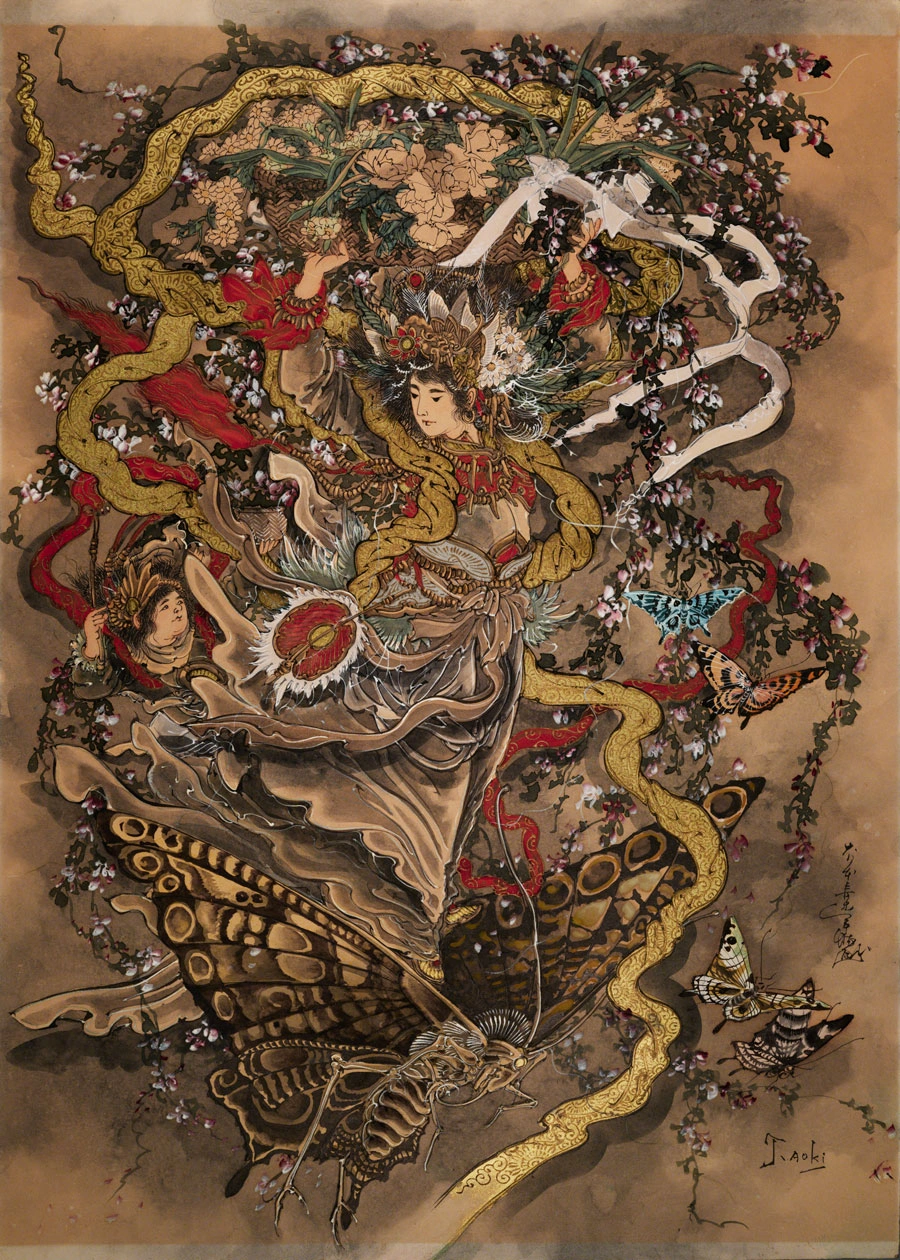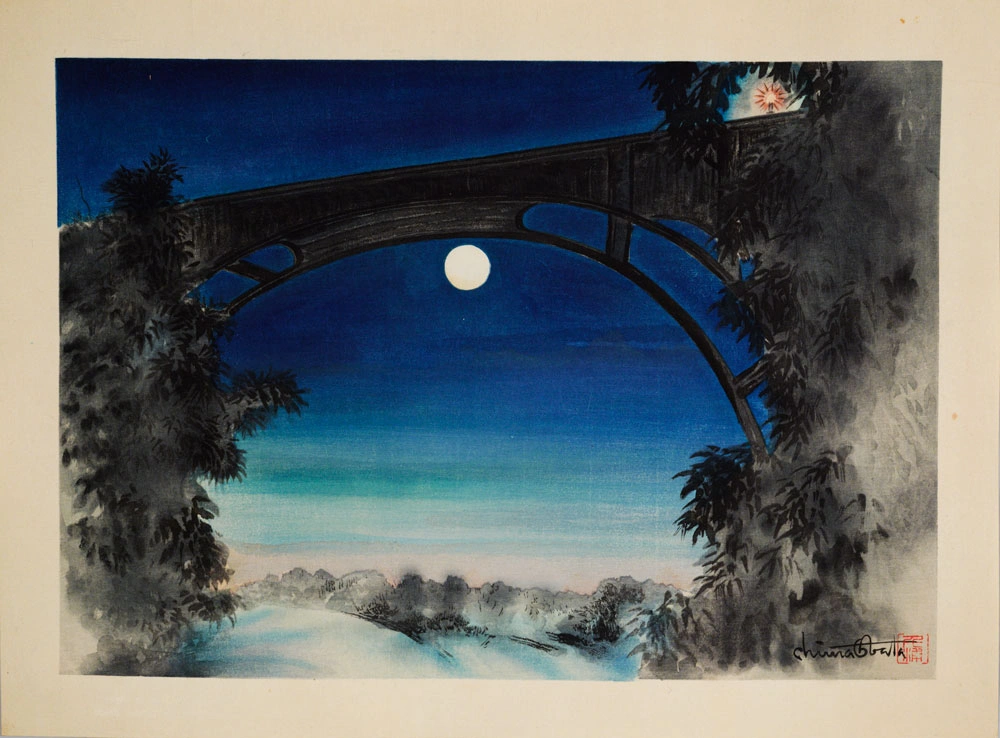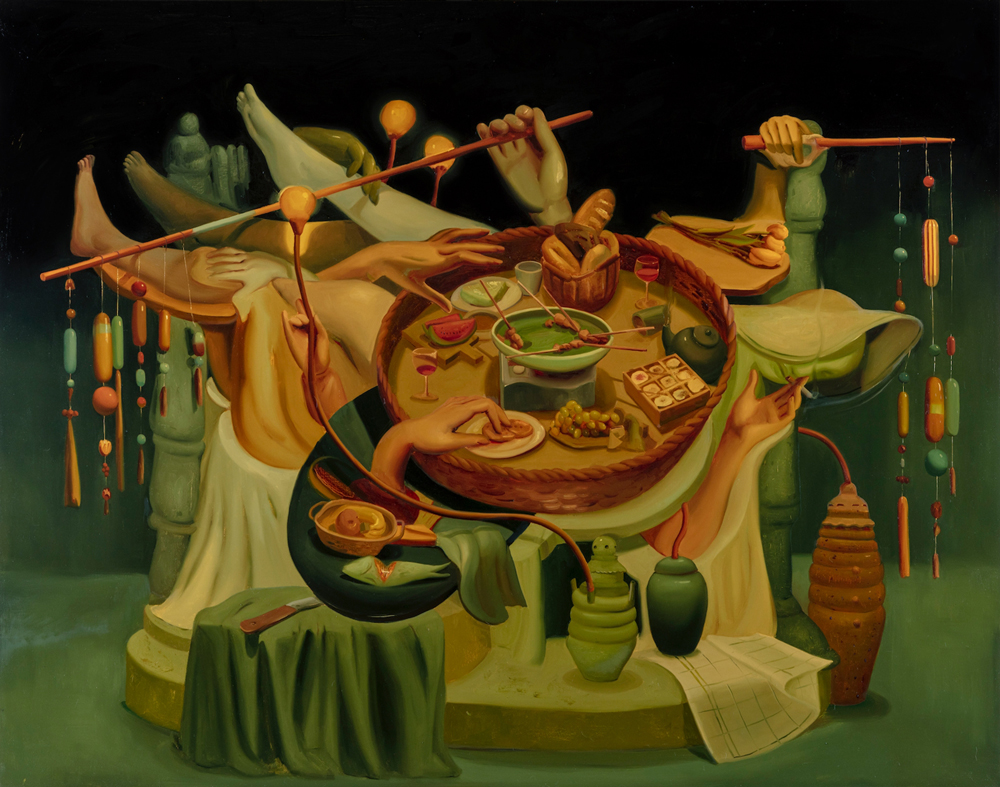
Dominique Fung (Canadian, b. 1987), Sans Les Mains, 2022, oil on canvas. Purchased with funds from Dominic and Ellen Ng. © Dominique Fung, 2022, courtesy of Jeffrey Deitch Gallery and Nicodim Gallery. | The Huntington Library, Art Museum, and Botanical Gardens.
The Huntington’s past and present are interwoven with Asian American history and identity. Chinese American laborers constructed the railroads in the 19th century that built the fortune of founder Henry E. Huntington. The Huntington’s Japanese Garden, built in 1911–1912, was in part created by Japanese master carpenter Toichiro Kawai. And, in 2008, The Huntington opened its Chinese Garden, expanding it in 2020. The Huntington is located at the heart of the San Gabriel Valley, which today is home to some of the largest Asian American communities in the nation. As a site for the preservation of the wide-ranging histories, cultures, and perspectives that make up the Asian American experience, The Huntington’s Art Museum has been embarking on the active collection and display of Asian American art.
One of the most exciting acquisitions this year is a monumental painting, Sans Les Mains (2022), by Chinese Canadian contemporary artist Dominique Fung. In it, a tangle of hands, legs, arms, and objects—trays, vases, French brie and baguettes, and an East Asian–style grill—comingle. Like much of Fung’s work, this painting references and critiques a work from the Western canon: Édouard Manet’s Le Déjeuner sur l’herbe (1863). Instead of Manet’s famous nude woman reclining on the grass next to a picnic, Fung’s woman is herself a picnic of Cantonese snack food—complete with skewers, a snack box, tea, watermelon, and cut fish. Fung’s exploration of the uncomfortable collapse of person and object speaks to the objectification of Asian women by male and Orientalist gazes. Things that are often ornamental in art history—like ceramic vases and the female body—are made strange, mysterious, and even uncomfortable in Fung’s painting, which resists being devoured.
Sans Les Mains is just one of several works by Asian American contemporary artists currently on view in the galleries. In the same gallery as Fung’s painting, two other works engage with Asian diasporic identity and culture. You can almost smell the smoke and feel the crackle of the explosion that produced Landscape Impressions, a 2008 drawing made of gunpowder by contemporary artist Cai Guo-Qiang. Cai arranges fuses, wooden boards, and explosive powders on top of a paper substrate—and then lights it. The subsequent path of the explosion and the smoke that emanates result in a drawing that is at once spontaneous and controlled. Evoking the fireworks of Cai’s youth in China, Landscape Impressions resembles a Chinese landscape or an abstract expressionist painting. Cai’s work is installed alongside the 1979 painting Global Loft (Spread) by Robert Rauschenberg, the American modernist who famously exhibited in Beijing in 1985, impacting the Chinese contemporary art scene and influencing a new wave of young Chinese artists.
Mineo Mizuno (American, born in Japan, 1944), Teardrop with Calligraphy “Zero,” 2010, ceramic. Purchased with funds provided by The Boardman Family Foundation, Linda Dickason, Margery and Maurice Katz, Steven and Kelly McLeod Family Foundation, Shula Mazarian, Lois and Richard Neiter, Mineo Mizuno, and Sue Tsao. © Mineo Mizuno. | Photo by Linnea Stephan.
Works by Japanese American ceramicist Mineo Mizuno are currently installed in both our American and European galleries. In the American galleries stands one of the artist’s signature forms: a teardrop, titled Teardrop with Calligraphy “Zero” (2010). Covered in a watery glaze, the monumental teardrop’s surface features the Japanese character meaning “zero” hand-painted thousands of times—pointing to the multiplicity of meanings contained in the single character, which can also mean nothingness, purity, falling water, or rain, and has come to stand in for Mizuno’s signature. In the Huntington Art Gallery, where European works are on view, you can see an installation of some of Mizuno’s newest works, including Thousand Blossoms (2020), a work composed of 3,000 handmade ceramic dogwood blossoms stacked into a tightly composed rectangle—a shape that echoes a doorway or a coffin.
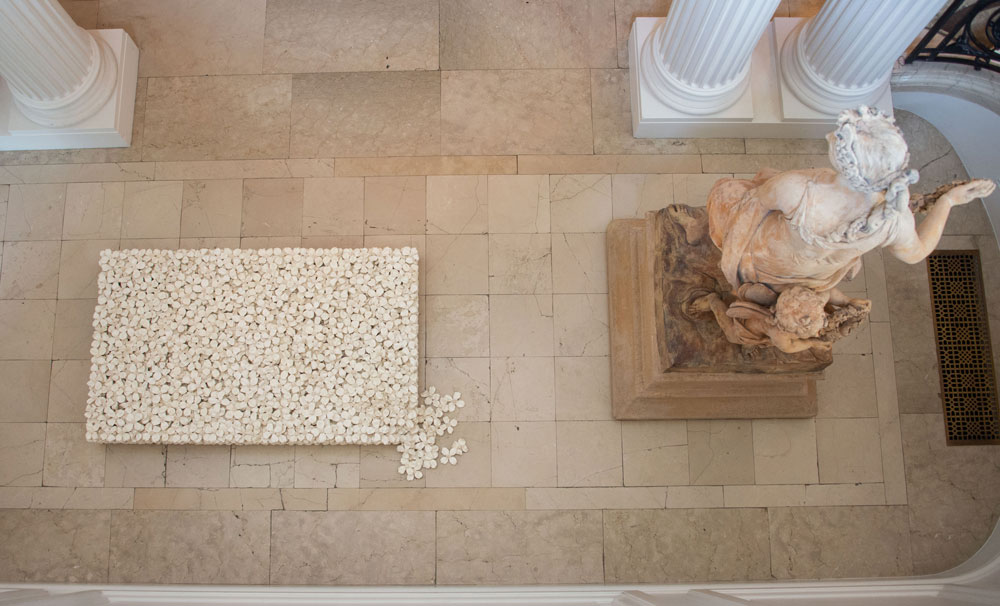
Mineo Mizuno (American, born in Japan, 1944), Thousand Blossoms, 2020, ceramic. Courtesy of the artist and Gagosian Gallery. © Mineo Mizuno, 2022. | The Huntington Library, Art Museum, and Botanical Gardens.
As a gesture of poetic disruption, the corner of the rigid stack seems to collapse, and a few blossoms scatter on the floor. Mizuno’s choice of dogwood flowers refers to his own past and present environments: Dogwoods bloom in Japan, where Mizuno was born, and in California near the Sierra Nevada Mountains, where he maintains his studio. Installed along with two other works by Mizuno, Thousand Blossoms activates two 17th-century terracotta figures in the hallway—representing a tree nymph and Flora, the ancient Roman goddess of flowering plants—that were carved for the Tuileries Garden in Paris. Mizuno’s artistic practice combines technical mastery of the ceramic medium with humanist meditations on the natural world and life cycles.
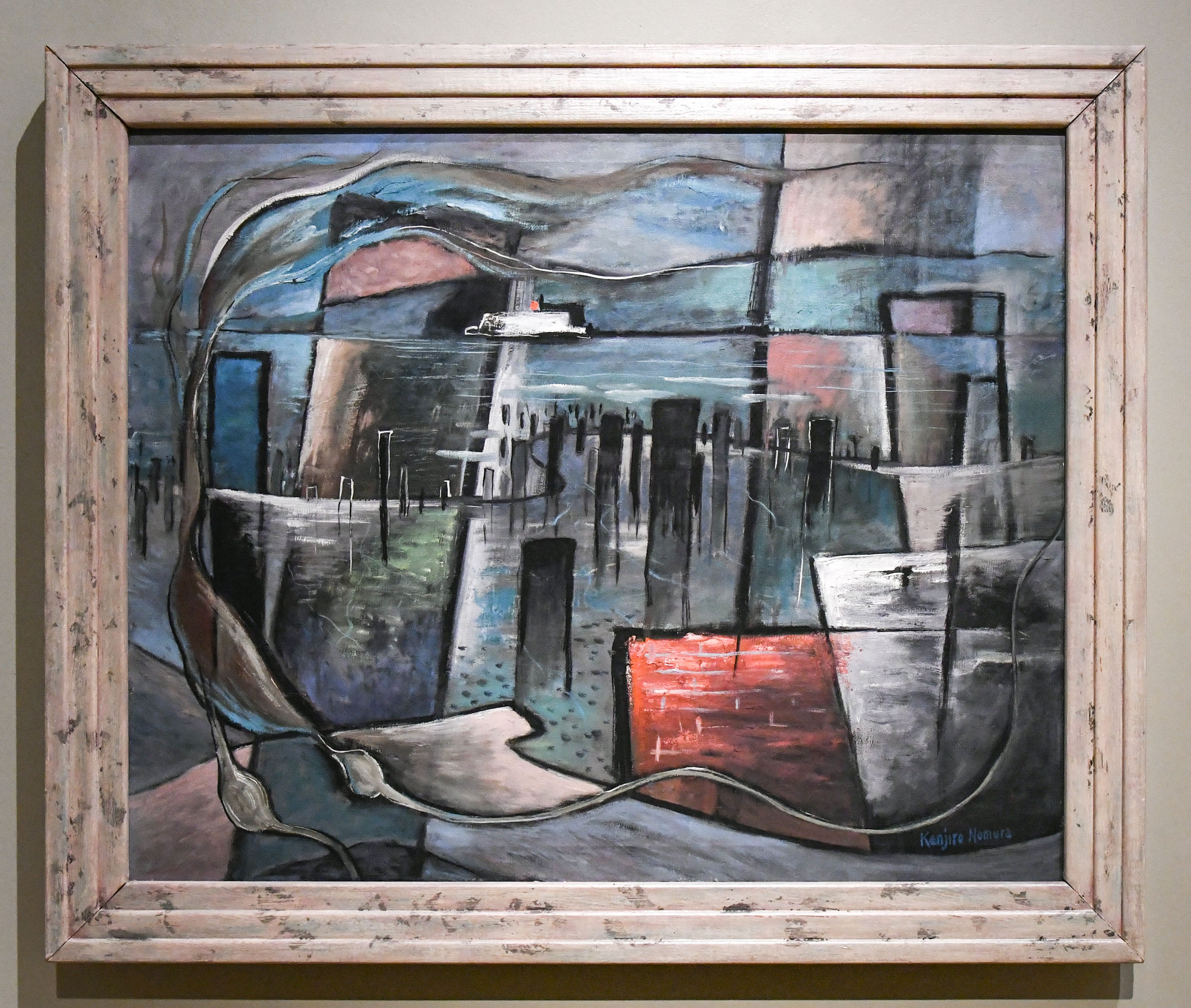
Kenjiro Nomura (American, born in Japan, 1896–1956), Puget Sound, 1947, oil on canvas. Gift of Robert Hori. Lisa Kidwell. The Huntington Library, Art Museum, and Botanical Gardens. | Photo by Linnea Stephan.
In addition to showcasing works by contemporary Asian American artists, The Huntington is expanding its collection of historic Asian American art. In the galleries of early 20th-century American art, visitors can view new acquisition Puget Sound (1947) by Japanese American painter Kenjiro Nomura. Nomura’s cubist composition depicts the Pacific Coast shoreline, marine life, and midcentury Seattle: Wood pilings in the ocean are framed by the tendrils of bull kelp and a line that suggests the fin of a stingray. On the horizon floats Seattle’s iconic ferry, the Kalakala. Nomura, who owned the Noto Sign Company, matured as a painter in the 1930s, depicting moody farm and street corner scenes. His life and career were tragically disrupted in 1942, when Executive Order 9066 mandated the incarceration of Japanese Americans on the West Coast; as a result, the Nomura family was forcibly incarcerated in the Minidoka War Relocation Authority camp in Idaho. Puget Sound was his first major painting after his return to Seattle in 1945, and it marked the beginning of his increasingly abstract style.
In the past several years, The Huntington has also increased its holdings of works on paper by important Asian American artists. In 2022, a rare watercolor entered our collection: a butterfly goddess by 19th-century Japanese American artist Toshio Aoki, who lived and worked at the Hotel Green in Pasadena. Living through the orientalist “craze” for Asian imports in the late-19th century, Aoki made a living working for G.T. Marsh, the successful importer of Asian art and antiques, from whom Henry Huntington purchased the house, ornaments, and fixtures for the Japanese Garden in 1911, and whose papers are preserved at The Huntington. The watercolor acquired by The Huntington is from Aoki’s series of mythological figures and goddesses, which read as representative of his own gothic, supernatural, and maximalist artistic vision—a kind of antidote to the decorative ornamentalism desired by his wealthy white Pasadena clientele.
In addition, The Huntington acquired a group of 1930s and 1940s photographs by Seattle-based Chinese American photographer Chao-Chen Yang. Among them is a black-and-white print of one of Yang’s most famous photographs, Apprehension (ca. 1940), which was featured on the cover of Artforum magazine in 2021. The film noir feeling of this photograph and others in the group, including Solitude (ca. 1939), give a sense of Yang’s cinematic approach to still images. A former apprentice at RKO Pictures, Yang had aspired to a career in filmmaking, and many of his photographs have the feeling of stills.
In 2019, The Huntington acquired Full Moon, Pasadena, California (1930), an exquisite watercolor by the major 20th-century landscape artist Chiura Obata. Obata depicts a tranquil white moon floating just below the arch of Pasadena’s historic Colorado Street Bridge. In addition to the original watercolor, the artist’s estate gave a series of 122 progressive woodblock prints that reveal Obata’s process of reproducing this Pasadena bridge scene with Japanese master printers at the Takamizawa Print Works in Tokyo.
The San Gabriel Valley and Southern California are home to the cultural inheritances of Asian America. These new acquisitions and installations of historic and contemporary Asian American art expand the stories we tell about American art at The Huntington—taking us from Pasadena in the 19th century to Brooklyn in the 21st—and in media ranging from gunpowder to film to ceramics. The collecting and exhibiting of Asian American art connect to our broader collections, building on the robust Pacific Rim library collections and the significant presence of the East Asian Gardens. Across its three collecting areas of library, art, and botanical, The Huntington continues to activate and preserve aspects of Asian American history and culture to serve our community in the San Gabriel Valley and beyond.
Yinshi Lerman-Tan is the Bradford and Christine Mishler Associate Curator of American Art at The Huntington.


